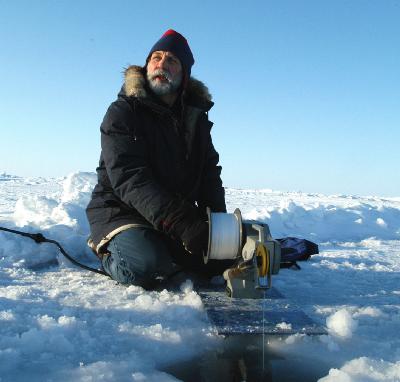October 30, 2003
Scientists meeting in Seattle to consider all aspects of Arctic change
It was something polar veteran Jamie Morison hadn’t seen in that part of the Arctic Ocean before.
As part of the North Pole Environmental Observatory program he heads, Morison was on a plane over a part of the Arctic Ocean where typically the surface would include a jumble of slabs, ridges and blocks of ice. The ruggedness of the surface indicates that the ice is a year or more old and would have remained like a seal over much of the surface of the ocean all summer.
This winter, however, for 100 miles, the ice in that area was smooth and flat, meaning it had formed after last summer.
“I was surprised,” Morison said of all that new ice.
Personal observations aside, the extent of sea ice in the Arctic in September 2002 was at its lowest point of the last 30 years, and this September the ice was again near that level.
Such changes are among the reasons more than 400 researchers traveled to Seattle this week for the first and largest meeting of international scientists studying all aspects of change in the Arctic. They are looking not just at the extent of the ice, but also shifts in ocean and atmospheric conditions and of how ecosystems and human communities are responding. The meeting is the first open science meeting under SEARCH, the Study of Environmental Arctic Change initiative, led by the National Science Foundation.
The scientists’ goal is to formulate new research strategies to understand the changes that are being observed.
“We don’t know the full extent or future course of Arctic environmental change,” says Morison, oceanographer with the UW’s Applied Physics Laboratory and chair of the SEARCH Science Steering Committee. “But we think we can understand it because the recent observations of the changing environment have given us new insights into how the Arctic system functions.”
Researchers said that four large-scale hypotheses undergird SEARCH investigations:
- Arctic environmental change is related to change in the atmospheric polar vortex, a large-scale cyclonic circulation in the atmosphere centered generally in the polar region.
- Arctic environmental change is a component of a more widespread change in climate.
- Feedback between the ocean, land and atmosphere are critical to the change process. The amount of ice, for example, or the lack of it, directly affects the amount of energy reflected back into atmosphere or absorbed by the ocean.
- Such physical changes have large impacts on the Arctic ecosystems and society.
“All the different disciplines where scientists see change in the Arctic are represented and being heard,” Jim Overland said of the meeting. Overland is an oceanographer with NOAA’s Pacific Marine Environmental Laboratory in Seattle and a UW affiliate associate professor. A native inhabitant from Kotzebue, Alaska, for instance, told the gathering that warm weather in the Arctic in recent years has changed the abundance and kinds of wildlife and has increased the number of accidents where even seasoned hunters and fishermen have misjudged ice conditions.
Other federal participants in SEARCH include NASA; NOAA; the Agriculture, Interior, Energy and Defense departments; and the Smithsonian Institution.
Morison pointed to Soviet programs that are no longer in existence and said it is worrisome to notice all these changes in the Arctic as programs monitoring such changes for the last 50 years have wound down or ceased. He said he hopes the meeting this week marks the start of a sustained, systematic program of large-scale observations and analysis in the Arctic.

